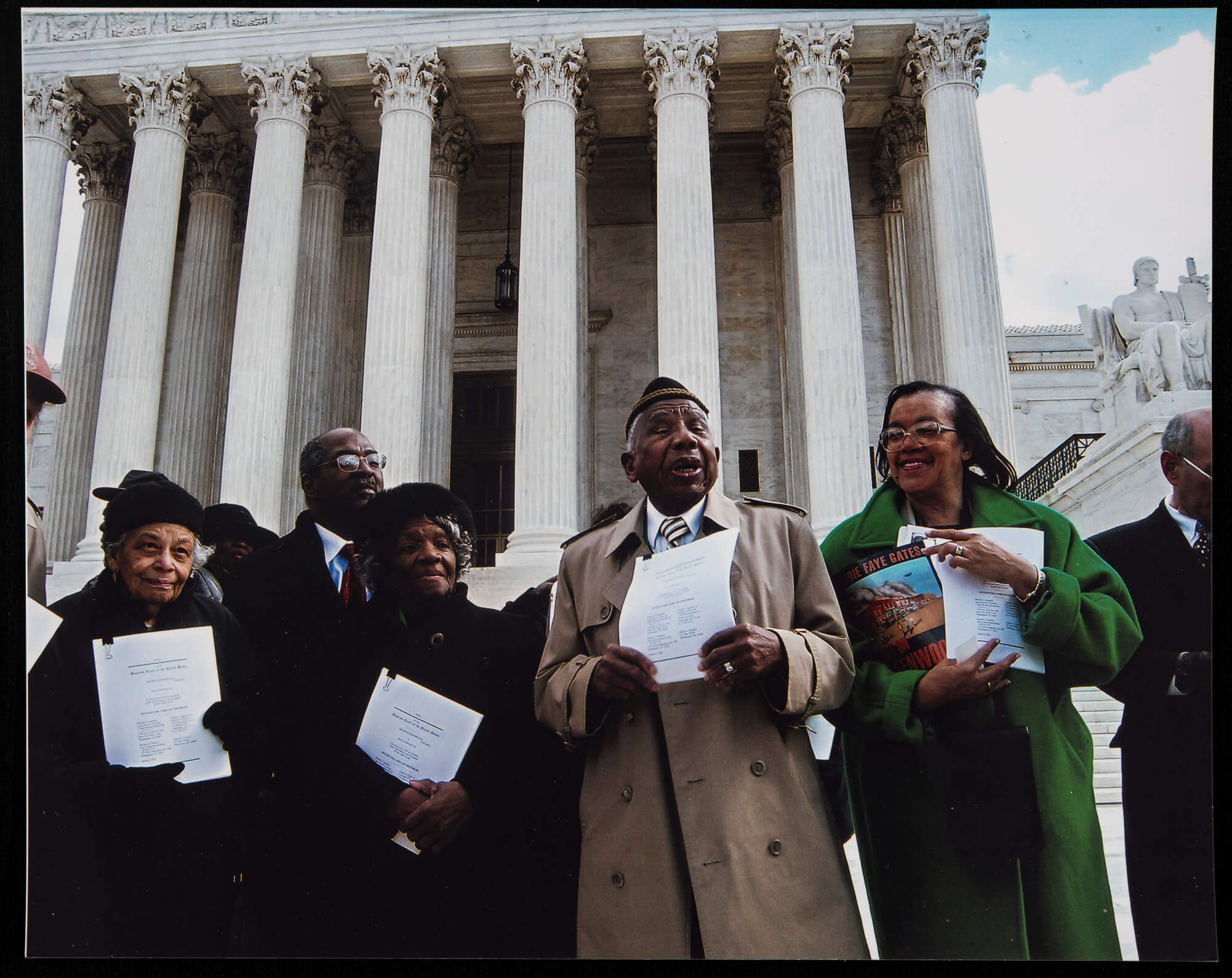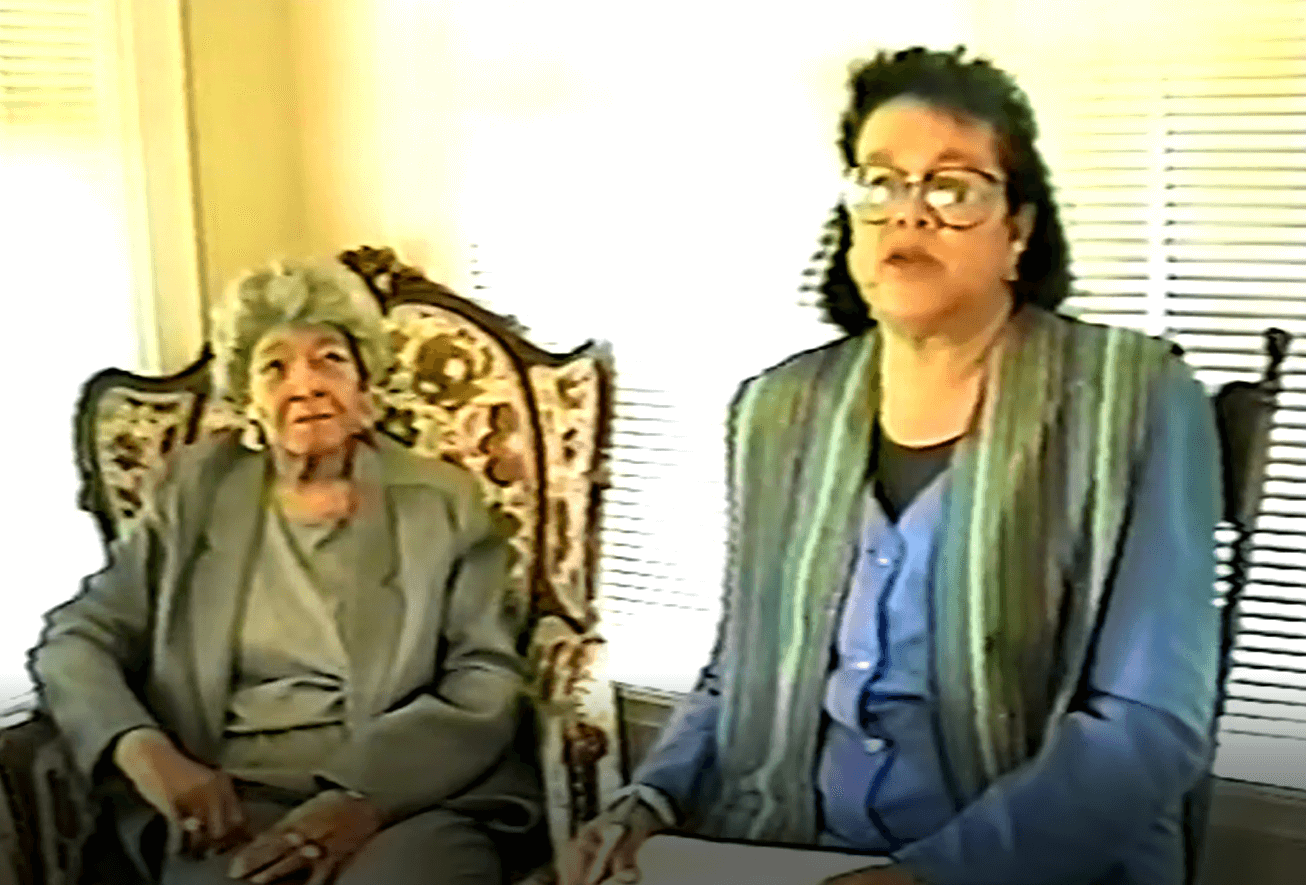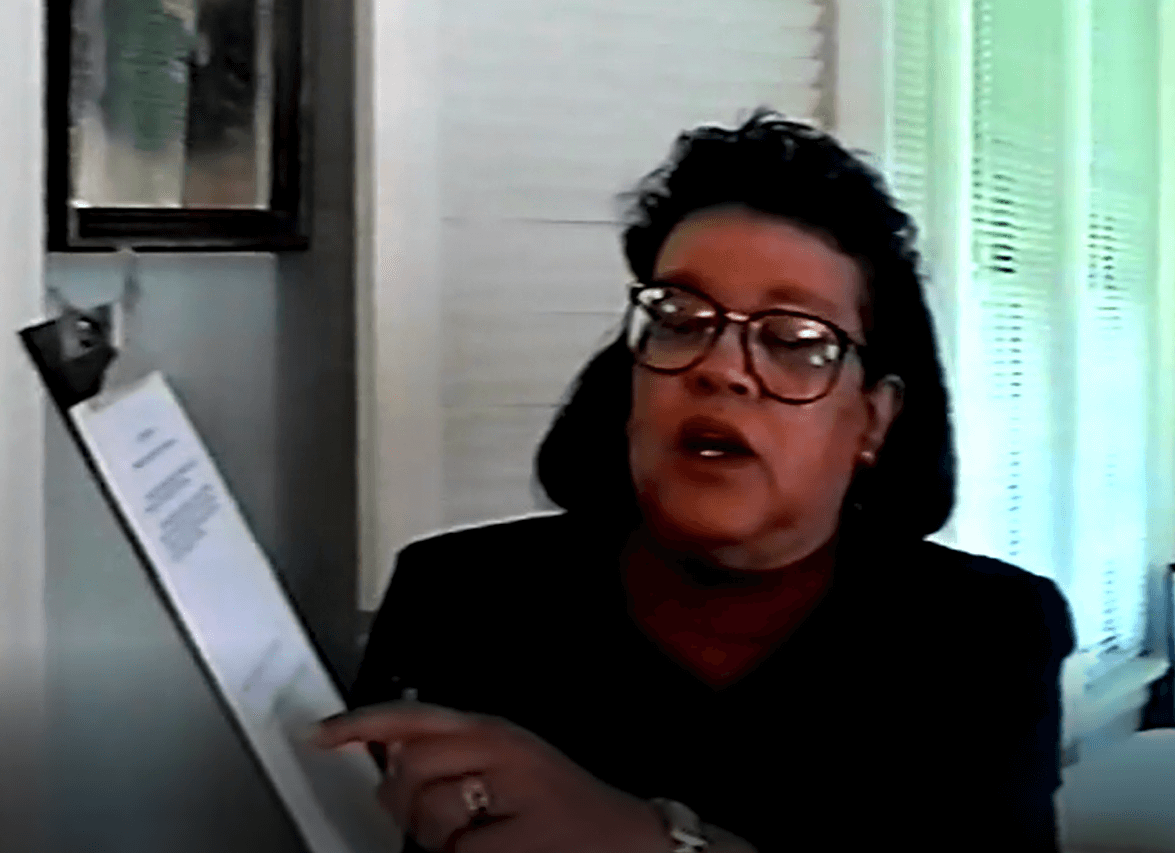Learning Objectives
- Students identify the impact of the Tulsa Race Massacre on survivors
- Students describe the survivors’ resilience despite the hardships endured as a result of the Tulsa Race Massacre
Guiding Questions
What impacts did the Tulsa Race Massacre have on survivors?
How did the survivors show resilience after the Tulsa Race Massacre?
Companion Collections

Photograph taken by Mrs. P. Telford of Eddie Faye Gates holding her book “Miz Lucy’s Cookies”, with Mr. Booker, and Essie J. Beck at Steve’s Bookstore

Photograph of Eddie Faye Gates with Lawyer Dr. Charles Ogletree Jr., Robert Holloway, Dr. Olivia Hooker, Thelma Thurman Knight, Otis Granville Clark, and others at a demonstration in support of reparations in front of the United States Supreme Court Building in Washington, D.C.

Tulsa Race Massacre Survivor Stories including interviews of Phineas Bell, Juanita Arnold, Essie Beck, Kinney Booker, KC Star, and more

Tulsa Race Massacre Survivor Stories including interviews of George Monroe, Iola Streeter Jackson, Venice Dun Sims, Kinney Booker, and more
Background and preparations
Preparing for Complicated Conversations
The history of the Tulsa Race Massacre is one of violence and oppression, which has a lasting impact for many people. To be sensitive to your students and your own responses, teachers are encouraged to consider practices and strategies to implement before, during, and after instruction.
Teachers are encouraged to first consider their own comfort level in leading discussions on racially motivated violence and managing strong emotions. Before the lesson, teachers should also spend time thinking about the ways that they will support students as they engage in discussions and learning that is complicated and emotional. Teachers need to ensure the classroom is a safe place for all students. Classes should establish or review norms, even create a community agreement or provide students with sentence frames for agreeing or disagreeing with their peers.
During the conversations, teachers should be prepared to manage the strong emotions of their students. In doing so, they should check in with students about the emotional and academic progress. Further have students self-reflect to identify their emotions, build empathy, and self-regulate.
Following the lesson, students need time to process and reflect on these conversations, and time to process the emotions that may have arisen during discussion. There are many excellent resources available online to help develop classroom communities and manage complicated conversations.
A Change in Nomenclature from Riot to Massacre
Since the time the oral histories of Tulsa Race Massacre survivors were conducted by the Oklahoma Commission to Study the Tulsa Race Riot, a shift in nomenclature from “race riot” to “race massacre” occurred.
Why? According to the Tulsa Historical Society and Museum “historically it has been called the Tulsa Race Riot. Some say it was given that name at the time for insurance purposes. Designating it a riot prevented insurance companies from having to pay benefits to the people of Greenwood whose home and businesses were destroyed. It was common at that time [and is written in many textbooks] for any large scale clash between different racial or ethnic groups to be categorized as a “race riot.’”
For greater historical accuracy, and to avoid wrongly placing blame for the massacre on the community of Greenwood, a shift from the term “race riot” to “race massacre” occurred. In 2018, the Commission changed their name from race riot to race massacre.
Class Handouts
- The Resilience of Greenwood Handout
- Oral History Note Catcher
- Note Catcher Answer Key
- Photo Analysis of Survivors at the US Supreme Court
Companion Videos
-
- George Monroe Interview:
- Eldoris McCondichie Interview:
- Essie Beck Interview:
Activities
Defining Resilience
1. Think-Pair-Share Prompt– Describe a time when a tragedy happened and a person or a group of people has bounced back despite being hurt, injured, or having something destroyed.
2. Share- Facilitate a large group discussion by sharing and reflecting on a time when people have moved forward despite tragedy.
1. Transition-
-
- Define the term “resilient” as the process of bouncing back and adapting well in the face of significant sources of stress, injury, or trauma.
- Students listen to a series of oral histories of the Tulsa Race Massacre survivors to identify the impacts of the massacre and how the people of Tulsa’s Greenwood community showed resilience following the massacre.
Background Information
1. Reading – students read the Resilience of Greenwood handout.
2. Discussion- ask students:
-
- What occurred during the Tulsa Race Massacre?
- What impact did the massacre have on survivors?
- How did the community of Greenwood show resilience?
3. Transition- say, Now we are going to listen to oral histories of survivors. Listen and identify the impact the massacre had on them personally and how they were resilient and rebuilt their lives despite this tragedy.
Oral Histories Video Clips
- George Monroe Interview:
5327.1686_george_clip1.m4v (1:58)
5327.1686_george_clip2.m4v (1:59)
5327.1686_george_clip3.m4v (1:50)
- Eldoris McCondichie Interview:
5327.1685_eldoris_clip1.m4v (5:08)
5327.1685_eldoris_clip2.m4v (2:02)
5327.1685_eldoris_clip3.m4v (:23)
- Essie Beck Interview:
5327.1685_essie_clip1.m4v (1:47)
5327.1685_essie_clip2.m4v (1:12)
5327.1685_essie_clip3.m4v (1:44)
5327.1685_essie_clip4.m4v (1:47)
1. Listening Protocol- Instruct students to fill out the oral histories note catcher. On the note catcher students identify the impact and resilience heard in each of the oral histories. An answer key is provided with a completed note catcher.
2. Listening- Students listen to the videos either independently or as a whole class. Alternatively, teachers could have students listen to just one of the stories and then jigsaw the information in small groups.
Assessment
S-I-T Reflection & Discussion of Oral Histories
In addition to the oral histories, you may also want to project an accompanying photo of Eddie Faye Gates with Tulsa Race Massacre survivors. 4327.10502
1. Writing Prompt- Students journal on the S-I-T prompt in their note catcher.
2. Small Group– In small groups students share their S-I-T responses.
3. Discussion– Then, engage in a class discussion using the following prompts:
-
- How did the Tulsa Race Massacre impact the lives of the survivors? What similarities did you hear in their stories?
- Despite the horrific events, how did the survivors and their families demonstrate resilience? How was the Greenwood community resilient?
Extensions
Students analyze a photo of survivors and advocates demonstrating for reparations in front of the US Supreme Court in 2005, using the Photo Analysis of Survivors at the U.S. Supreme court handout. Students will identify how this photo represents the resilience of the Greenwood Community.
During a discussion of the photo, teachers may note that Eddie Faye Gates, a member of the Oklahoma Commission to Study the Tulsa Race Riot of 1921, holds her book Riot on Greenwood. The commission sought to uncover the truth about the event of the massacre, record essential oral histories from survivors, and seek reparations for the victims. They investigated and wrote a report on the massacre. The work of the commission ultimately helped to uncover much of what occurred in the Tulsa Race Massacre, and provided information the survivors used in their case for reparations. In her book Gates identifies unintended consequences of the commission including “riot focused healing and reconciliation programs all over the nation.” Although the survivors were unsuccessful at acquiring reparations at that time, they do demonstrate the strength and resilience of the Greenwood community.
Bibliography
“1921 Tulsa Race Massacre.” Tulsa Historical Society & Museum, www.tulsahistory.org/exhibit/1921-tulsa-race-massacre/.
“The Case for Reparations in Tulsa, Oklahoma.” Human Rights Watch, 28 Oct. 2020, www.hrw.org/news/2020/05/29/case-reparations-tulsa-oklahoma#_Toc41573966.
Gates, Eddie Faye. Riot on Greenwood: the Total Destruction of Black Wall Street, 1921, Out on a Limb Publishing, 2006, pp. 189.
Johnson, Hannibal B. Black Wall Street 100: an American City Grapples with Its Historical Racial Trauma. Eakin Press, 2020.
Johnson, Hannibal B. Black Wall Street: from Riot to Renaissance in Tulsa’s Historic Greenwood District. Lightning Source Inc., 2013.
Messer, Chris M., et al. “The Destruction of Black Wall Street: Tulsa’s 1921 Riot and the Eradication of Accumulated Wealth.” American Journal of Economics and Sociology, vol. 77, no. 3-4, 2018, pp. 789–819., doi:10.1111/ajes.12225.
Let’s Talk Facilitating Critical Conversations with Students, Learning for Justice, 2019.
Modifications
For students who struggle to understand the videos in this section, teachers may show the videos twice using the following steps. 1.) Have students listen to the video. 2.) Discuss the video’s important points. 3.) Review the questions on the oral histories portion of the student note catcher. 4.) Watch the video a second time while having students complete the answers in the guide.
Content standards
Oklahoma Social Studies Practices
3.A.6-8.1 Gather, compare, and analyze evidence from primary and secondary sources on the same topic, identifying possible bias and evaluating credibility.
4.A.6-8.1 Paraphrase the main idea and cite evidence from primary and secondary sources; provide an accurate summary of a source distinct from prior knowledge or opinion.
4.B.6-8.3 Engage in collaborative discussions and debates about information presented in social studies texts, expressing ideas clearly while building on the ideas of others.
C3 Framework
D2.His.14.6-8. Explain multiple causes and effects of events and developments in the past.
D2.His.15.6-8. Evaluate the relative influence of various causes of events and developments in the past.
D2.His.16.6-8. Organize applicable evidence into a coherent argument about the past.
